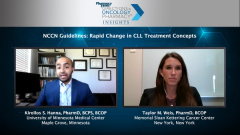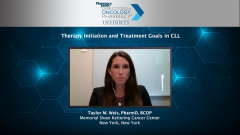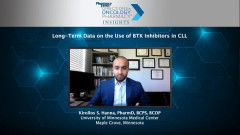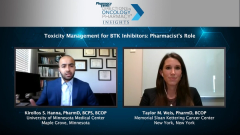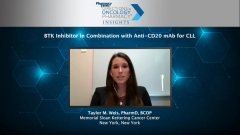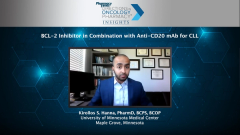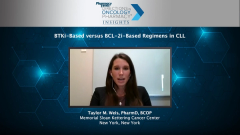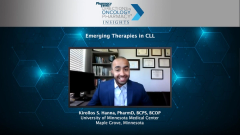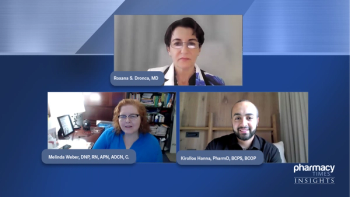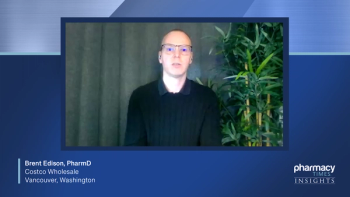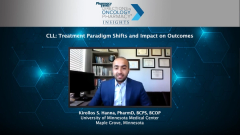
Toxicity Management for BTK Inhibitors: Pharmacist’s Role
Taylor M. Weis, PharmD, BCOP, discusses the role of pharmacists in toxicity prevention and management with BTK inhibitor therapy in CLL.
Episodes in this series

Kirollos S. Hanna, PharmD, BCPS, BCOP: One thing I would love to hear a bit from you about is toxicity management with BTK [Bruton tyrosine kinase] inhibitors. Although we’re seeing very low incidence of grade 3/4 [adverse effects] and they are very well tolerated, what’s your perspective and what is your role as a pharmacist in intervening when patients report potential [adverse] effects? What are the most common [adverse] effects you see in clinical practice? What are concerning [adverse] effects that we really try to watch out for, such as cardiovascular issues, bleeding, things like that? And is there anything that we know of, maybe like genetic markers or anything we’re beginning to see in terms of trends, that put a patient at more risk for developing a certain toxicity over another? I would love to hear what your experience has been there.
Taylor M. Weis, PharmD, BCOP: Yes. Pharmacists have a very important role in CLL [chronic lymphocytic leukemia] clinics in terms of caring for patients on these agents. You did allude to this a bit earlier, talking about are we seeing these [adverse] effect rates, does what we are seeing in the trials correlate with clinic practice? I would say, somewhat yes, although we’re having real-world data emerging, retrospective studies looking at patients treated with ibrutinib specifically, that actually cite discontinuation rates may be higher than what we see in a very motivated clinical trial patient. Some real-world studies are citing maybe 42% discontinuations overall, with the majority being due to adverse events. This is 1 in 5, or 1 in 4 patients who you see in your clinic on a BTK inhibitor who will stop because of adverse events. As clinical pharmacists, we know that this is unacceptable. There is so much we can do to help minimize these, and pharmacists who are embedded in the clinics have the ability to help these patients at all different time points across their treatment. For example, before they start treatment, while they’re on treatment, when they’re selecting therapies and trying to go through that. Basically, before a patient even starts treatment, the role of the pharmacist in our clinic is to screen patients’ comorbidities, screen their medications. These BTK inhibitors, as you know, have a lot of drug-drug interactions, and pharmacists have a key role in managing these interactions. Acalabrutinib and ibrutinib are both CYP3A4 substrates. Acalabrutinib is a P-gp substrate, and there are other minor CYP interactions that come into play as well. A lot of times we can catch a lot of drug interactions and prevent a lot of unnecessary toxicities just by cleaning up the patient’s medication list or switching them to alternative therapies.
One thing that comes up a lot in the oncology population is a lot of people are on herbal supplements to help with different types of ailments. They can buy these over the counter, order them online, and they may not think there’s anything wrong with it because it’s an over the counter medication. But there are a lot of these medications that interact with these BTK inhibitors and can increase exposure and ultimately toxicity. A common one off the top of my head is turmeric, which a lot of patients are on. We try to avoid those at all costs because we know that ibrutinib can have much higher systemic concentrations when given with a moderate or strong CYP3A4 inhibitor. That is before a patient even starts treatment. While they are on therapy we’re regularly checking in with the team of the patient, seeing how they are doing on treatment. Pharmacists have a really big role in this area because we know what [adverse] effects to look out for. We know when they occur, and we know ways to medically manage them at home for the most part.
What I like to do whenever I’m monitoring a patient in the clinic is ask them, “What is the most bothersome symptom you’re experiencing at this time?” By asking them this question you can see what is most bothersome to them. What [adverse] effect is bothering them so much that are considering not taking their medication at home. By asking this question I’m often able to figure out what is the biggest problem the patient is facing. Then the question comes up, do we push through? Do we just give them supportive care medications, do we reduce the dose? As a general strategy, I typically think of it as I look at the CTCAE [Common Terminology Criteria for Adverse Events] grading criteria. For these minor grade 1 or 2 [adverse] effects, which seem mild, we typically try to push through, give them supportive care, continue the dose, if at all possible, especially early in therapy when the disease burden is high. However, some of these grade 1 and 2 adverse events, if you actually look at what that means, they can still be very bothersome for patients, and sometimes can still be so bothersome that they may skip a dose of medication at home. Thus, there is always discussion there too. We may consider dose holds for grade 1 to 2 [adverse] effects. For more severe grade 3 to 4 toxicities, that’s really when we’re thinking about holding the medication. Grade 3 and 4 is when we may discontinue permanently as well. Hence, there are a lot of different considerations there.
Often the question comes up too, if we are reducing the dose or holding the medication, are we potentially affecting the patient’s efficacy from this medication? Would we be better off switching therapies all together? There are some respective analyses that have tried to answer this question in a real-world setting. There was a study by [Paul] Barr, [MD,] and colleagues that was published in Blood [American Society of Hematology publication] in 2017 that found that patients who did have prolonged dose holds, which they consider as greater than 8 days, and had overall lower dose intensities, did seem to have increased progression events. However, this is very subject to bias with these retrospective analyses, and in contrast we have a phase 1 study and another retrospective study that found that after the first 1 to 2 months of therapy, patients who had lower doses, so maybe went from 420 mg to a lower dose of ibrutinib after the first 2 months, didn’t have any increased risk of progression. This suggests to us that maybe, especially when the disease burden gets down, patients may still have adequate BTK inhibition on lower doses, but still may be tolerating their medication well.
Kirollos S. Hanna, PharmD, BCPS, BCOP: Those are all extremely excellent points and you also brought up one very good thing, the drug interactions. It’s a big factor for pharmacists. Concerning acalabrutinib specifically, how easy is it for someone to walk into a grocery store, maybe even a gas station, pick up a PPI [proton pump inhibitor], get on the PPI, and it’s a contraindication to use these specific acid suppressants with acalabrutinib? But another thing too, is many of these drugs we can use with or without food, but people don’t know that high-fat, high-caloric meals impact absorption of both ibrutinib and acalabrutinib, so we always have to look at these things.
Transcript edited for clarity.
Newsletter
Stay informed on drug updates, treatment guidelines, and pharmacy practice trends—subscribe to Pharmacy Times for weekly clinical insights.

